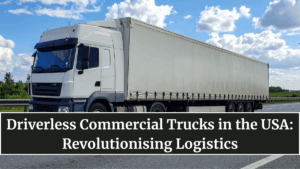The race toward autonomous commercial truck deployment in the USA is redefining how goods move across the country. With the logistics sector facing driver shortages, rising fuel costs, and increasing demand for faster deliveries, self-driving trucks are emerging as a transformative solution. What was once science fiction is now becoming a billion-dollar reality, with major pilots already running on U.S. highways.

The Evolution of Driverless Truck Technology
Autonomous trucking builds on the same technologies that power self-driving cars—LiDAR, radar sensors, AI-driven vision systems, and GPS mapping—but adapted for long-haul freight operations. Companies have developed Level 4 autonomy, which allows trucks to operate without human intervention on pre-mapped routes, especially on highways with consistent traffic flow.
These driverless trucks can maintain lane positions, regulate speed, and respond to other vehicles and environmental conditions using advanced machine learning algorithms. The result? Lower accident rates, higher efficiency, and 24-hour operation without fatigue or rest requirements.
Why the U.S. Logistics Industry Needs Autonomous Trucks
The U.S. logistics industry is at a critical inflection point. According to the American Trucking Associations (ATA), the country is short of nearly 80,000 truck drivers as of 2025 — a number expected to rise further.
Autonomous trucks promise to:
-
Reduce dependence on human drivers, especially for long, monotonous routes.
-
Increase fleet productivity by operating continuously without mandated rest breaks.
-
Lower fuel consumption through optimized driving algorithms.
-
Enhance safety by reducing accidents caused by fatigue and distraction.
-
Cut logistics costs by 20–30% in the long term.
These advantages make self-driving freight one of the most promising technological disruptions in the U.S. transportation sector.
Key Players Leading the Revolution
Several tech startups and automakers are already running pilot programs and partial deployments of driverless trucks across states like Texas, Arizona, and California.
| Company | Headquarters | Key Focus | Highlights |
|---|---|---|---|
| Aurora Innovation | Pittsburgh, PA | Autonomous Freight | Partnering with FedEx and PACCAR for autonomous deliveries |
| TuSimple | San Diego, CA | Long-haul Automation | Testing self-driving trucks across Texas and Arizona |
| Kodiak Robotics | Mountain View, CA | Driverless Freight | Focus on scalable, highway-ready driverless tech |
| Einride | Stockholm / Austin | Electric + Autonomous Freight | Combining autonomy with sustainability |
| Gatik AI | Palo Alto, CA | Short-haul Autonomous Delivery | Partnered with Walmart and Kroger for middle-mile logistics |
These companies are working with major carriers and retailers to integrate autonomous trucks into existing logistics networks, gradually moving from test routes to full-scale deployment.
The Role of Regulation and Policy
Regulatory frameworks are rapidly evolving to accommodate the driverless trucking revolution. States such as Texas, Arizona, and Florida have already legalized the operation of autonomous trucks without onboard human drivers.
The U.S. Department of Transportation (USDOT) and National Highway Traffic Safety Administration (NHTSA) are working on nationwide safety standards, focusing on:
-
Data sharing protocols between vehicles and road networks.
-
Cybersecurity compliance to prevent hacking of autonomous systems.
-
Liability guidelines for accidents involving driverless vehicles.
-
Fleet monitoring systems to ensure operational transparency.
Meanwhile, federal funding under the Infrastructure Investment and Jobs Act (IIJA) is supporting smart road infrastructure, such as sensor-equipped highways that can communicate directly with self-driving trucks.
Benefits & Challenges in Autonomous Trucking
Benefits:
-
Cost reduction: Automated fleets lower fuel and labor expenses.
-
Safety improvements: Fewer human errors lead to reduced crash rates.
-
Environmental gains: Optimized driving means lower emissions.
-
Supply chain efficiency: Quicker deliveries and fewer idle hours.
Challenges:
-
Regulatory inconsistency: Different states have varying laws for autonomous operations.
-
Public skepticism: Concerns remain over job losses and road safety.
-
High development costs: Self-driving technology requires billions in R&D.
-
Cybersecurity threats: Connected fleets could be vulnerable to digital attacks.
Despite these challenges, the rapid pace of innovation and investment suggests that widespread adoption is not far off.
The Road Ahead: A New Era for Freight Movement
By 2030, autonomous trucks could account for 10–15% of U.S. long-haul freight, drastically improving delivery speed and efficiency. Fleet operators are already planning hybrid systems where driverless trucks handle highway routes, while human drivers manage urban “last-mile” deliveries.
Additionally, the integration of electric drivetrains and AI logistics optimization is creating the foundation for a future where trucking is cleaner, safer, and far more efficient.
Autonomous trucks aren’t just changing logistics—they’re reshaping America’s economic backbone. With every successful trial, the U.S. moves closer to a world where goods travel seamlessly across thousands of miles, guided not by human hands, but by intelligent, self-learning machines.
FAQs
What is an autonomous commercial truck?
It’s a self-driving heavy-duty vehicle equipped with AI, LiDAR, radar, and GPS systems to operate safely without constant human input.
Which companies are leading the autonomous truck market in the U.S.?
Aurora, TuSimple, Kodiak Robotics, Einride, and Gatik AI are pioneering self-driving freight technologies in active trials.
Are driverless trucks legal in the U.S.?
Yes, in several states like Texas, Arizona, and Florida, autonomous trucks are already allowed to operate commercially under specific safety regulations.
What are the main benefits of autonomous trucks?
They reduce operational costs, improve safety, and enable 24/7 freight movement without human fatigue.
Will self-driving trucks replace human drivers?
Not entirely. Initially, they will complement human drivers, handling long-haul segments while people manage local routes and complex urban navigation.
Click here to know more.
